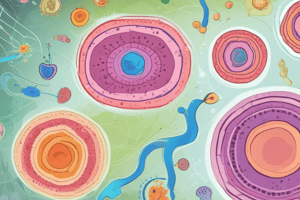Podcast
Questions and Answers
Homeostasis refers to the ability of organisms to maintain a stable internal environment.
Homeostasis refers to the ability of organisms to maintain a stable internal environment.
True (A)
What is the primary focus of ecology?
What is the primary focus of ecology?
The interactions between organisms and their environment.
Which of the following is NOT a key component of the hierarchical system of classification?
Which of the following is NOT a key component of the hierarchical system of classification?
- Domain
- Kingdom
- Species
- Habitat (correct)
The movement of elements like carbon, nitrogen, and water through living and non-living parts of ecosystems is described by ______ cycles.
The movement of elements like carbon, nitrogen, and water through living and non-living parts of ecosystems is described by ______ cycles.
Match the following biological concepts with their definitions:
Match the following biological concepts with their definitions:
Which of the following is NOT a key branch of biology?
Which of the following is NOT a key branch of biology?
Prokaryotic cells have a nucleus.
Prokaryotic cells have a nucleus.
What is the primary function of mitochondria?
What is the primary function of mitochondria?
The process of converting DNA information into proteins is called ______.
The process of converting DNA information into proteins is called ______.
Which of the following is NOT a major class of biological molecules?
Which of the following is NOT a major class of biological molecules?
Match the following terms with their corresponding definitions:
Match the following terms with their corresponding definitions:
Briefly explain the concept of natural selection.
Briefly explain the concept of natural selection.
Genetic drift is a random process that can change the frequency of alleles in a population.
Genetic drift is a random process that can change the frequency of alleles in a population.
Flashcards
Biology
Biology
The scientific study of life and living organisms.
Cell Theory
Cell Theory
Cells are the basic structural and functional units of living organisms.
Prokaryotic Cells
Prokaryotic Cells
Cells that lack a nucleus and membrane-bound organelles.
Eukaryotic Cells
Eukaryotic Cells
Signup and view all the flashcards
Carbohydrates
Carbohydrates
Signup and view all the flashcards
Proteins
Proteins
Signup and view all the flashcards
Natural Selection
Natural Selection
Signup and view all the flashcards
Mutation
Mutation
Signup and view all the flashcards
Biodiversity
Biodiversity
Signup and view all the flashcards
Biogeochemical cycles
Biogeochemical cycles
Signup and view all the flashcards
Homeostasis
Homeostasis
Signup and view all the flashcards
Physiology
Physiology
Signup and view all the flashcards
Study Notes
Biology Overview
- Biology is the scientific study of life, encompassing a wide range of topics.
- It explores the structure, function, growth, origin, evolution, and distribution of living organisms.
- Key branches include botany (plants), zoology (animals), microbiology (microorganisms), and genetics (heredity).
- The scientific method is crucial in biological research, involving observation, hypothesis formation, experimentation, data analysis, and drawing conclusions.
- Cell theory states that cells are the fundamental structural and functional units of all living organisms.
Cell Structure and Function
- Cells demonstrate varied structures and functions adapted to their roles in organisms.
- Key components include the cell membrane (regulating entry/exit), cytoplasm (gel-like substance), nucleus (housing genetic material), and diverse organelles.
- Examples of organelles are mitochondria (energy production), ribosomes (protein synthesis), and endoplasmic reticulum (protein modification).
- Prokaryotic cells lack a nucleus and membrane-bound organelles, while eukaryotic cells possess these features.
- Various organelles perform specialized tasks to maintain cell structure and function.
Biological Molecules
- Four primary classes of biological molecules are essential for life: carbohydrates, lipids, proteins, and nucleic acids.
- Carbohydrates supply energy and provide structural support.
- Lipids store energy, form membranes, and act as hormones.
- Proteins perform diverse functions including catalysis, transport, and structural roles.
- Nucleic acids store and transmit genetic information (DNA and RNA).
Genetics
- Genetics explores heredity, the transmission of traits from parents to offspring.
- Genes, segments of DNA, code for proteins.
- DNA replication accurately duplicates genetic material.
- Transcription and translation convert DNA information into proteins.
- Mutations in DNA can cause variations and heritable changes in organisms.
Evolution
- Evolution is the change in heritable characteristics of biological populations over generations.
- Natural selection, where organisms better suited to their environment survive and reproduce more efficiently, drives evolution.
- Genetic drift, random alterations in allele frequencies, can also influence evolution.
- Speciation is the formation of new, distinct species during evolution.
- Biodiversity, the variety of life on Earth (genes to ecosystems), arises from evolutionary processes.
Ecology
- Ecology investigates the interactions between organisms and their environment.
- Ecosystems, communities of organisms interacting with each other and their physical surroundings, are central to ecological studies.
- Food chains and webs depict energy flow through trophic levels.
- Biogeochemical cycles (e.g., carbon, nitrogen, water) describe the movement of elements between living and non-living parts of ecosystems.
- Human impact on the environment is a critical area of ecological study.
Classification
- Biology employs a hierarchical classification system to organize living organisms.
- Carl Linnaeus developed the system, arranging species based on shared characteristics and evolutionary relationships.
- This system spans various levels, from species to domain, reflecting the hierarchical nature of life's diversity.
Homeostasis
- Homeostasis maintains a stable internal environment in organisms.
- Feedback loops regulate bodily functions like temperature, pH, and water balance to ensure optimal operation.
Organism Physiology
-
Physiology studies the normal functions of living organisms, from molecules to systems.
-
This encompasses organ function and relationships between them.
-
Examples include the functioning of the nervous, circulatory, digestive, and respiratory systems.
-
Biology encompasses a wide range of phenomena, from molecular interactions to complex ecosystems, illustrating the intricate interconnectedness of life.
Studying That Suits You
Use AI to generate personalized quizzes and flashcards to suit your learning preferences.




